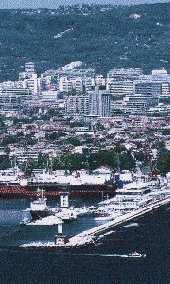|
|
| |
BULGARIA
VARNA
Varna is Bulgaria's third largest city. It was an inhabited place even before the Greeks established the colony of Odessos there about 580 B.C. Later, under the Romans and their successors, the Slavs, Varna became a major port trading with Constantinople, Venice and Dubrovnik. In 1393 it was captured by the Turks, who made it an important military centre.
Nowadays it is the main port for both naval and commercial shipping and, adjacent as it is to the coastal resorts of Golden Sands, St. Constantine (Drouzhba) and Albena, it has a cosmopolitan atmosphere. Sailors on shore-leave in unfamiliar ceremonial uniforms, mingle with foreign tourists and locals as they promenade along shady boulevards, lined by dignified 19th and early 20th century buildings.
The 19th century Cathedral of the Assumption of the Virgin is an imposing landmark, which contains a finely carved iconostasis and bishop's throne, some interesting murals and stained glass.
The 2nd century thermae are the remains of the largest Roman public building in Bulgaria. During this century enough has been revealed by archaeologists to give a good impression of the original layout, though some parts of the building remain hidden under nearby streets. Coming across an extensive ancient building amidst the streets and houses of a modern city is not unusual in Bulgaria, but is always a delight.
Further from the centre, a granite monument commemorates the Battle of Varna, which took place in 1444. Here 30,000 Crusaders were waiting to sail to Constantinople when they were attacked by 120,000 Turks. The Polish King Ladislas was killed in a bold attempt to capture the Sultan Murad. The subsequent retreat foreshadowed Christendom's general retreat before the advancing Ottomans.
North of Varna there is a cluster of seaside resorts all with fine - sandy beaches but differing in size and style.
 The Varna Museum is full of treasures from all periods of the city's history, and will interest both the informed archaeologist and the casual visitor. In 1972 excavations in the Varna Necropolis revealed almost two thousand gold artefacts from about 4000 B.C. One stunning display case has the bones of a tribal leader arranged with skilfully-made jewellery and personal possessions around him. Some of the finds are displayed behind magnifying glass to reveal the complex and minute details of the craftsmanship. Some items are thought to be the oldest worked gold so far discovered. Other exhibition halls contain Greek and Roman antiquities, including some fine ceramics; icons, weapons and materials from the 19th century struggle against the Ottoman Empire.
Other museums include the Ethnographic Museum, with interesting displays of costumes and jewellery, and examples of folk customs such as the embroidered masks used in the Kukeri and Survakari rituals, and different-shaped loaves baked for festival days. The Natural History Museum focuses on coastal flora and fauna.
|
|
|
Festivals and Fairs
The Great Koprivshtitza Folklore Festival
The Great Koprivshtitza Folklore Festival is Bulgaria's largest gathering of traditional musicians and singers and is a cross between a pop festival and a medieval fair. It is a sight that knows no equal: thousands of musicians and singers making the hillside above the picturesque village of Koprivshtitza their home for a few days. Coupled with this you have the colourful stalls of the traders and the thousands of visitors who come for the festival.
This is Bulgarian music as it was always played, played by the ancestors of those who first played it. But perhaps it is what happens on the periphery that is the most authentic. Strolling players or soloists, simply playing for the sheer enjoyment. forming new bonds with other musicians or just letting their music ring out over the hillside.
The Bourgas International Folk Festival
The Bourgas International Folk Festival, held annually, attracts a host of Bulgarian and international artists and is held in the second half of August.
The Kazanluk Festival
The Kazanluk Festival of the Roses is held annually in early June, and has grown from a local to an international event. Not only are the roses, Kazanluk's main industry, in full flower. but the town itself blossoms while visitors enjoy the "Rose Picnic" and all the fun of a folklore festival, with its costumes, songs and dance. Should you still have the energy left, you can always visit the old factories where the rose oil is extracted.
St. Trifon's Day
In the agricultural calendar, St. Trifon's Day celebrates the pruning of the vines, and is held on February 14.
Kukerov Den
On the first Sunday before Lent, Kukerov Den celebrates the start of the agricultural year, and all over Bulgaria you can witness processions led by the dancing. leaping Kukeri dressed in colourful masks and costumes.
Baba Marta
Baba Marta is celebrated on March 1 when peasant house-holds brush out the winter cobwebs with a traditional spring clean. and people offer each other tokens of good luck called martenitsas.
Kukeri
Like western countries. the Bulgarian calendar is dotted with important feast days and festivals. The festival of the Kukeri re-enacts ancient surovaki rites to ward off evil spirits and Kukeri fertility rites. Although only held once every five years, it brings together dancers from all over Bulgaria in a rainbow of colours and styles.
St. Lazarus Day
Lazaruvane is also celebrated in spring on St. Lazarus Day, and here village girls considered fit for marriage perform ritual songs and dances.
St. Konstantin and St. Elena Day
The coming of summer is traditionally celebrated on St. Konstantin and St. Elena Day on May 21, and in some of the remoter villages in the Stranzha hills fire dancing, dancing on heated coals, is still practised in celebration of summer's arrival. Ethnologists have suggested that this practice is directly descended from Dionysina rites of the ancient Thracian.
|